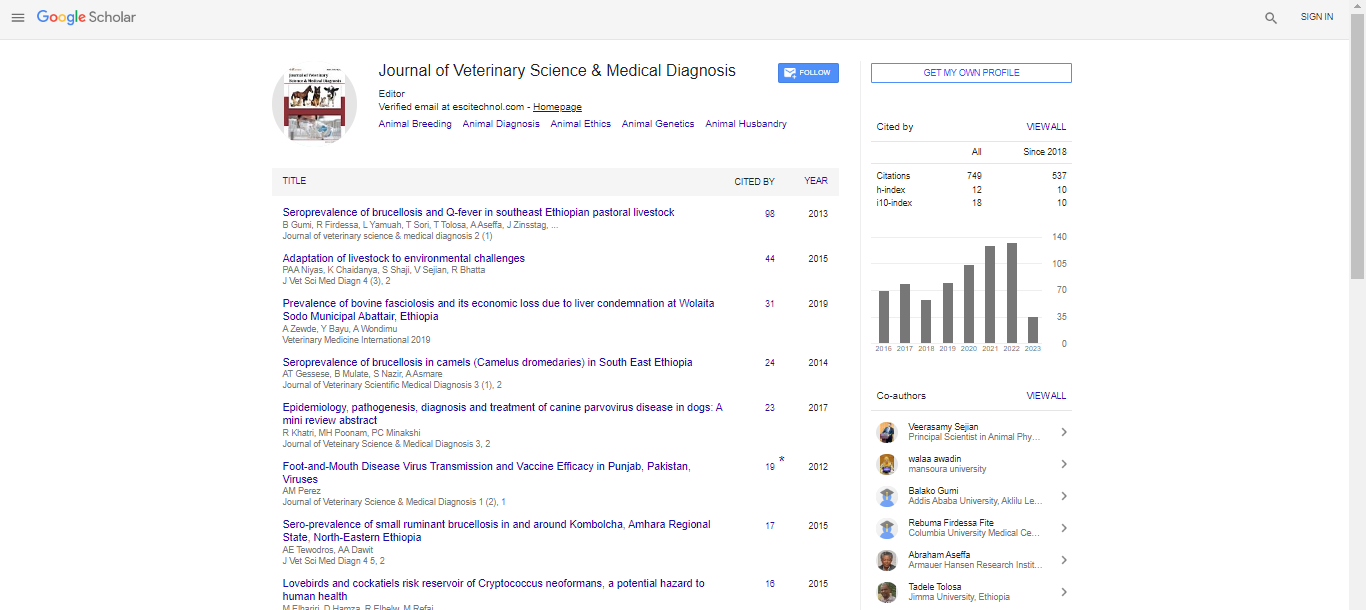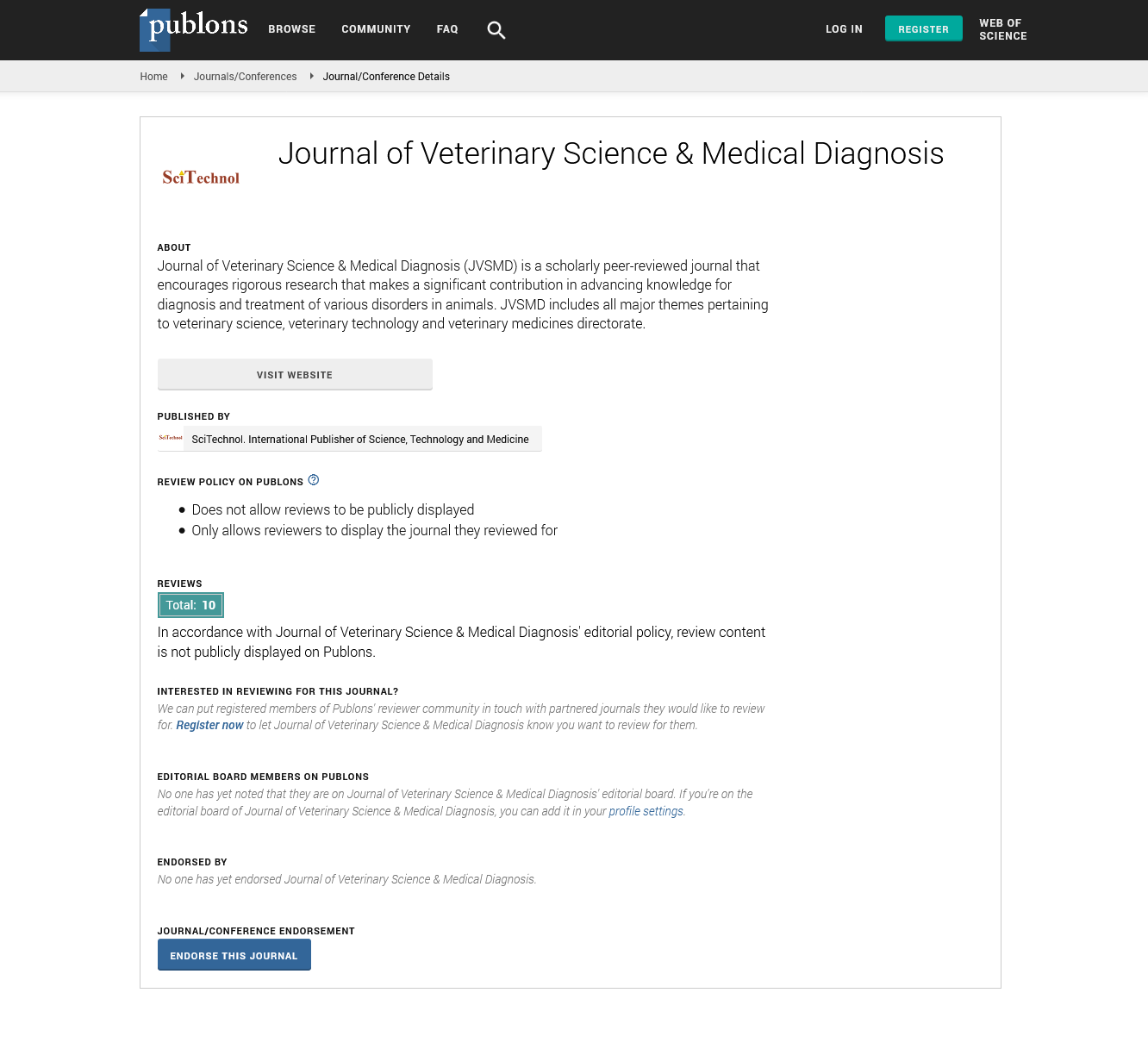Perspective, J Vet Sci Med Diagn Vol: 11 Issue: 2
Management for Wild Life Farming with Two Probiotic Strains
Thomas Rundberget*
Faculty of Biosciences and Aquaculture, University of Nordland, Bodo, Norway
*Corresponding Author: Thomas Rundberget
Faculty of Biosciences and Aquaculture, University of Nordland, Bodo, Norway.
E-mail: trundberget@gmail.com
Received date: 07 January, 2022, Manuscript No. JVSMD-22-60930;
Editor assigned date: 10 January, 2022, Pre QC No. JVSMD-22-60930 (PQ);
Reviewed date: 24 January, 2022, QC No. JVSMD-22-60930;
Revised date: 04 February, 2022, Manuscript No. JVSMD-22-60930 (R);
Published date: 14 February, 2022, DOI:10.4172/2325-9590.11.1.009
Citation: Rundberget T (2022) Management for Wild Life Farming with Two Probiotic Strains. J Vet Sci Med Diagn 11:2.
Keywords: Wild Life Farming
Description
A significant danger to the endurance of numerous untamed life species in non-industrial nations is reaping of untamed life for meat or different products like bones, skins, horns, tusks, and bladders. To shield species from overhunting, different (correlative) protection measures are utilized. The critical bits of knowledge to defend imperiled species from unnecessary hunting pressure depend on straightforward financial aspects preservation endeavors ought to be intended for decreasing the advantages of collecting or expanding its expense. Data crusades, for instance, are pointed toward bringing down buyer interest by defaming the utilization of specific natural life products (e.g., ivory utilization in Europe and the United States). Accordingly, request therapists and costs fall, dissolving the productivity of gathering exertion and bringing down hunting pressure. Authorization by antipoaching units, conversely, raises the expense of poaching by presenting a normal fine or punishment. In specific nations, like Zimbabwe, Nepal, and Kenya, punishments can be all around as extreme as being shot to no end (Messer 2002). The two methodologies raising expenses and lessening benefits-have been powerful with fluctuating levels of achievement. Raising shopper mindfulness and adjusting human inclinations, in any case, are troublesome and tedious and frequently have just restricted sway. Observing and requirement are clear arrangements, yet they are costly. Furthermore, cost is a not kidding thought considering strict spending plan imperatives and monetary deficiencies in many non-industrial nations. It is nothing unexpected, then, at that point, that there is a consistent quest for new and more savvy ways of improving protection. One rather new, market-based way to deal with limit gathering has all the earmarks of being picking up speed; we consider it the "supply-side methodology" to natural life preservation. Strangely, its fundamental allies are financial experts, not preservation scientists. Supply-side preservation intends to give a modest substitute to the natural life product being referred to, discouraging the wares' market cost, which brings down hunting motivations and powers gatherers to look for elective business. Supply-siders suggest "flooding" the market for untamed life products with cultivated assortments or with different substitutes like amassed merchandise or compound substitutes. For instance, Viagra has impacted the exchange velvet from reindeer prongs, harp seals, and hooded seal penises-generally wares endorsed as aphrodisiacs in conventional Asian medication.
The Difficulty of Reaching Sustainable Harvest
Reaction frequencies are introduced as rates. Because of the open idea of meetings, the quantity of respondents fluctuates among questions, and accordingly frequencies additionally are displayed as parts of the all out number of interviewees that were posed that inquiry. While thinking about questions that expected a mathematical reaction, assuming interviewees gave a reach, measurements were determined from the midpoint of the reach. A Pearson's connection was utilized to assess the value pattern of adolescent author stock over the long haul. Costs were changed over to US Dollars at the money swapping scale for the important year (OANDA, 2008), and adapted to expansion to the 2008 rate (BLS, 2008). Benefits and costs of cultivating and exchanging were determined utilizing mean qualities assembled from the meetings. The costs of wild meat versus cultivated meat identical were contrasted and a one-way ANOVA, and a Tukey's post hoc assessment. The cultivated meat comparable was determined by separating the mean cost of cultivated reproducing age author stock matches by the mean detailed most extreme load of a grown-up porcupine, and afterward divided to represent just a single person.
The constant appearance of pioneers in the Amazon locale and the resulting increment of hunting strain and deforestation for farming and animals creation has disintegrated the chance of accomplishing practical hunting in these districts. The recently shown up settlers are more specific, showing inclinations for ungulates and enormous birds, and not at all like the native occupants they gather an overabundance. This sort of hunting will in general adversely influence the populaces of warm blooded animals and huge wild birds, whose job is fundamental in keeping up with the woods' biology through, for instance, their activities in scattering and predation of seeds and seedlings. These issues are highlighted because of the generally low regular game efficiency in the Neotropical woodlands.
Wildlife Commodity Traders
In the Amazon area, the yearly creation goes from 152 to 488 kg/km2. Robinson and Redford proposed that the most minimal efficiency values ought to be viewed as while assessing supportability (152 kg/km2 which is comparable to simply 1.52 kg/hectare). As human populaces increment above 1.0 individual/km2, the manageability of hunting a considerable lot of the favored species was lost because of this low efficiency. Subsequently, the chance of accomplishing reasonable hunting must be accomplished with the execution of the board procedures. One such system could be the execution of a source-sink model, for example, no-hunting or restricted hunting zones, as was taken on in the TamshiacuTahuayo Community Reserve in the Peruvian Amazon. Information gathered from the Peruvian Amazon, which included impacts other than hunting on creature populaces, like sickness and movement, were utilized to assess the greatest maintainable yearly collect for certain species. The yearly greatest maintainable gather for the caught peccary (Pecari tajacu) is roughly 0.3 creatures/km2 . The live weight of a normal chased peccary is 17.5 kg (Robinson and Redford 1991), in this manner the yearly reap of 0.3 creatures/km2 is identical to 5.2 kg/km2 , which likens to scarcely 36 g of peccary meat/hectare/year. This figure is far underneath the revealed mean meat utilization for the Neotropics (205.9 g/individual/day). In any event, when different species other than peccary are incorporated, the absolute manageable gather of 1.52 kg of creatures per hectare or 1.0 kg of game meat/hectare/year isn't to the point of providing the interest for meat by the rising human populace living in the Amazon district.
In this segment we sketch the fundamental model prodding the hopeful conviction that supply side strategies can add to protection of jeopardized species. The model depends with the understanding of "poachers", reaping a creature populace under states of open access. Individual poachers don't have property freedoms to the asset, and regularly go about as static enhancers. Passage in the "poaching area" happens as long as the profits to poaching for the minor participant surpass the profits to exertion somewhere else in the economy, and exit happens when the converse is true.4 Assume that the peripheral expense of poaching exertion expansions in exertion, and that people can supply one unit of exertion (so that total exertion is indistinguishable from the quantity of poachers). Expanding minor poaching costs are caused, for instance, on the off chance that people must be drawn in from other progressively beneficial elective occupations. Indicating U as the net result from poaching for the minimal poacher, the elements of total poaching exertion E are characterized as (smothering time documentation)
 Spanish
Spanish  Chinese
Chinese  Russian
Russian  German
German  French
French  Japanese
Japanese  Portuguese
Portuguese  Hindi
Hindi 
